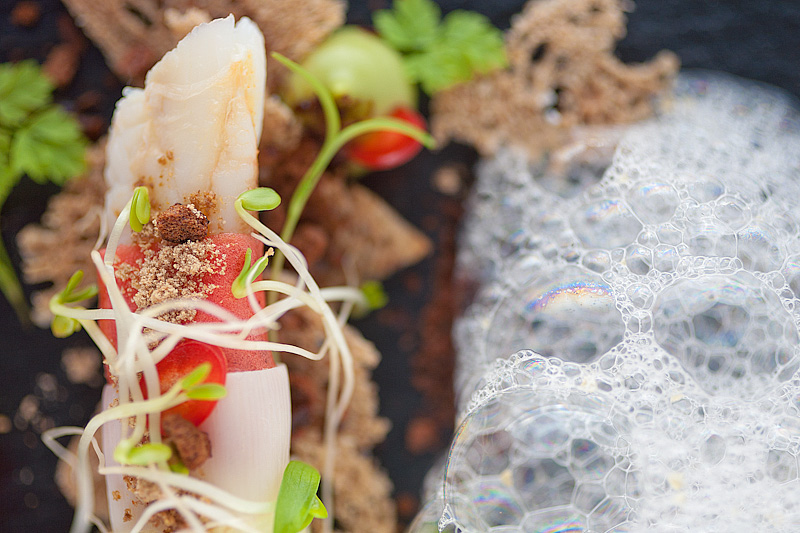
Makin’ DISCOVERIES!
Makin’ discoveries is so great you guys. I made lots of discoveries on this dish! It was super-fun for some non-obvious reasons that might only apply to super duper food geeks like e.g. yours truly.
First let’s talk about what we have here. A long log of crab leg meat is wrapped with thin layered ribbons of cucumber, passion fruit leather, and heart of palm. This crabby candy-cane-y thing is plated on some thin shingles of sesame-seasoned whole wheat bread, avocado pudding, and shards of freeze-dried soy. The crab is topped with passion fruit seeds, coriander salt, fresno chile slices, cilantro microgreens, and clover and alfalfa sprouts. Alongside all of this sits a large pile of what looks like dish soap, but is in fact coconut bubbles. The flavors are bright and very springtimey.
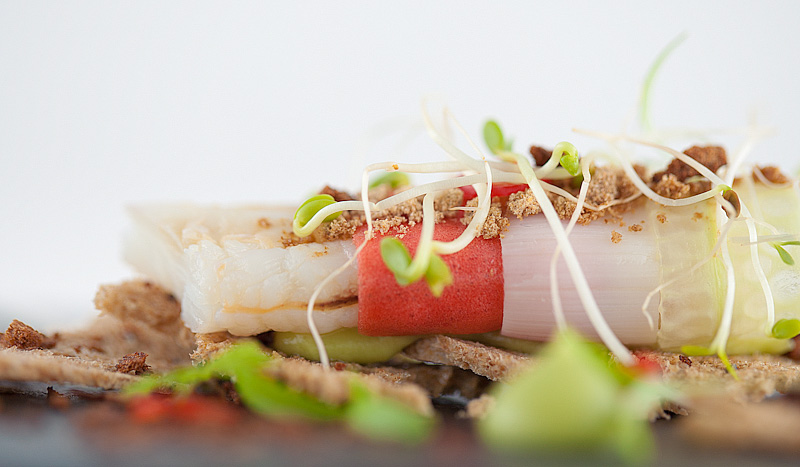
A few months back, Sarah and I had dinner at Boot & Shoe Service , a fantastically-named Oakland restaurant that’s one of our favorites. While there we got a salad of fresh spring greens and dungeness crab with diced avocado cubes and meyer lemon, and it was beautiful. I thought “Yup, crab and avocado go together like peanut butter and jelly, or like chicken and a chicken container.” This recipe builds off that combination and adds a few neat surprises along the way. It’s super-tasty.
The recipe calls for king crab; it specifically says “X cooked king crab legs”. Google searches for “king crab bay area” lead almost-exclusively to…Costco. No other grocery store I’ve been in carries king crab, either fresh or frozen. Some research led me to understand that the ‘season’ for Alaskan king crab lasts maybe 3-4 days, and since live king crabs apparently don’t transport terribly well (full wingspan of these sea spiders can be around 6 feet long; maybe they just can’t find a pilot willing to fly a planeful of giant armored spiders down here? [Reminder to self: watch some reruns of Deadliest Catch to learn more science]), most of what you can find is pre-cooked and flash-frozen. I asked a butcher at Berkeley Bowl about this and was told the frozen legs weren’t nearly as amazing as the fresh ones. I figured Alinea must have some crazy way of sourcing fresh Alaskan King Crab, but figuring out how they might do this ranks up there with Perigord truffles on my “how do you devils defy the seasons?!” list of questions for them.
Further hunting led me to several Alaskan sites for fish resellers like this one where I could have several pounds of cooked-and-frozen king crab legs overnighted to me (for, as you can see, a not-insignificant sum), and the most promising link I found was this, which offers ‘fresh cooked clusters’ seasonally (though it’s not clear to me how this differs). But Costco or mail-order approach aside, it seemed like my option was either to 1) fly to alaska on a very, very specific day to get fresh crab and make this dish RIGHT THERE, or 2) buy frozen pre-cooked crab. The “X legs of cooked king crab” in the book makes me suspect maybe Alinea is doing this as well? But is dropping nearly $100 for a single leg of frozen crab meat the maximum awesome thing to do here?
In scouring around fish markets, one thing I can find easily is fresh, live dungeness crab. While not nearly the size or the beauty of king crab, dungeness is hyper-fresh and local, and even though it’s sort of out of season by this time of year it’s still straightforward to find. So do I overnight this pre-cooked king crab stuff, or do the ‘buy local’ thing? I vacillated on this for a few weeks before finally deciding to keep it local and snag a nice feisty dungeness from Market Hall in Rockridge.
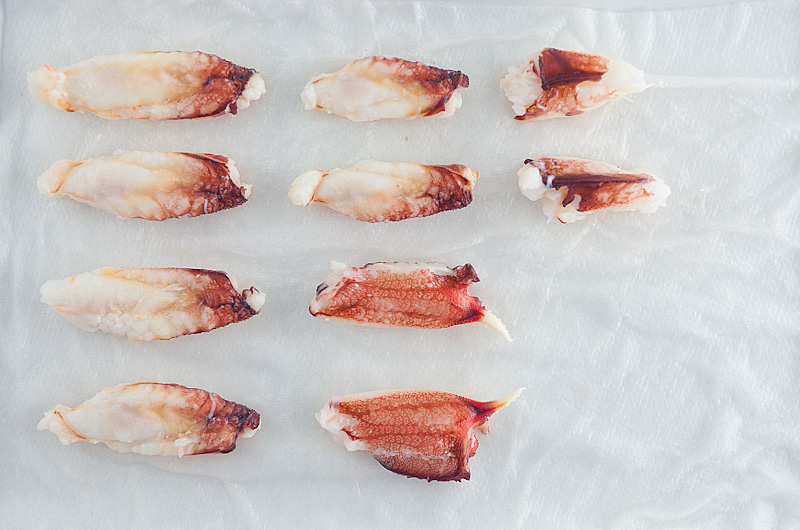
I dispatched this guy the same way I did the lobster a few weeks back, feeling notably less remorse because 1) it was really mean, it hissed at me and moved around really fast and did some other scary things and 2) I’m pretty sure it called my mom fat at one point. I could be mistaken about 2), but whatever. The legs on these things are quite a bit shorter than those of their king crab brethren, and the meat is a little rusty-looking and not really as pretty as a log of king crab meat, but I decided to roll with it the best I could. I mean, it tasted great.
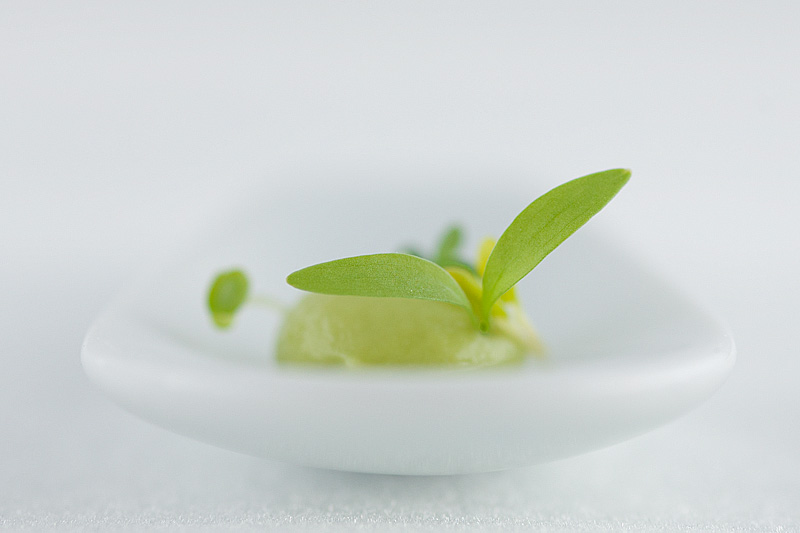
Crab meat secured, I got busy with everything else. I first made avocado pudding, which just involved blending a ripe avocado with some glucose, salt, and lime juice. The glucose helps give structure and a smooth consistency (compared to sugar crystals), and the citric acid in the lime juice locks the color of the avocado so it stays bright green.
I then worked on making passionfruit leather. This was neat; I started by removing all the flesh from the passionfruit, and trying to remove as many seeds as I could.
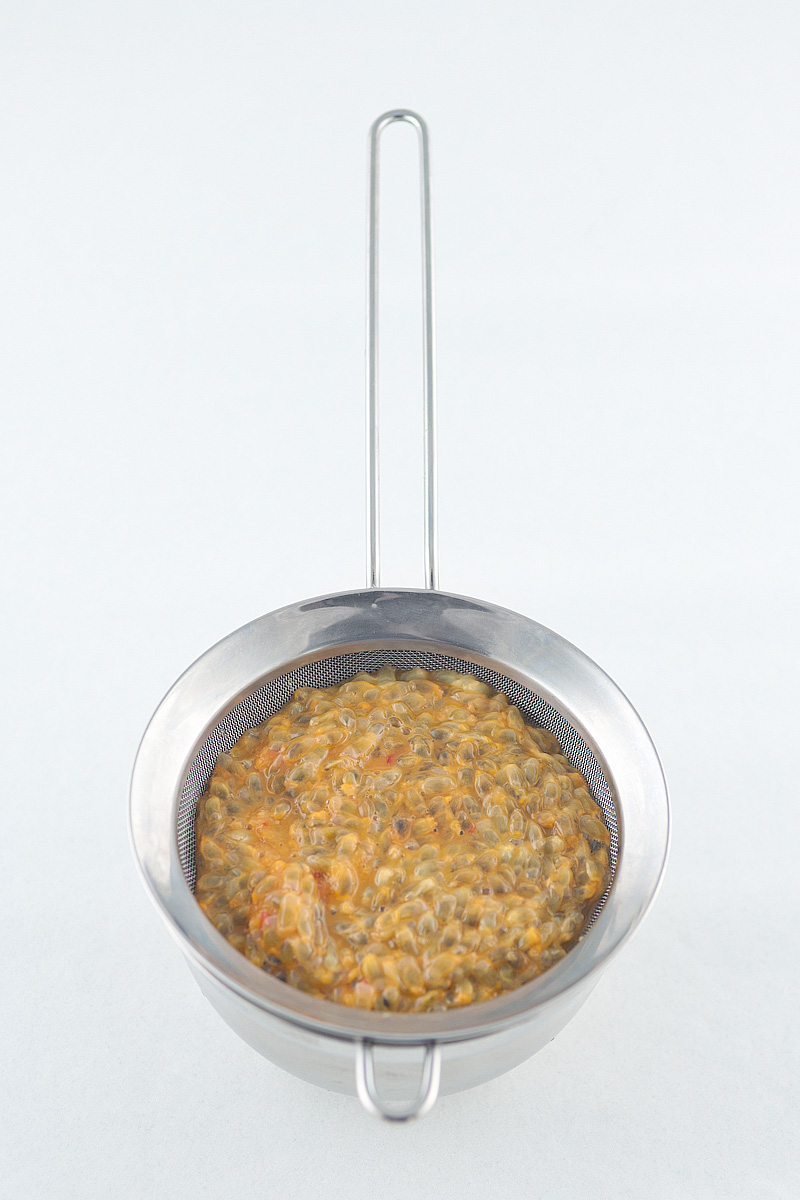
Then I cooked the rind in simple syrup and let that steep for an hour, yeilding a lovely magenta passionfruit syrup.

The flesh and syrup were blended with some water, ultra-tex 3, and xanthan gum until the mixture thickened a bit. This was fascinating to me; the stabilizers helped keep the mixture thick and spreadable in the dehydrator, and also added, um, ‘heft’ and thickness to the final leather (otherwise it would have turned into a thin, crispy film rather than something chewable).
This is where Neat Discovery #1 happened. I bought a giant batch of Sciency White Powders when I started this project, and while I’ve replaced several them since (because I ran out), there are many that are used in small enough quantities that I haven’t mowed through the entirety of them yet. My jar of Xanthan is one such example; it’s about 3 years old, and I can’t recall the last time I used it in a recipe. Most of the powders seem to have held up fine during this time; they behave as I expect and I can’t tell that there’s anything ‘wrong’ with them, so I haven’t bothered to drop more money on replacing them without knowing why I should.
When I opened my jar of Xanthan, I noticed immediately that it had a smell. Not a rotten-like one or anything, it just smelled…stale. Sort of like really dusty cardboard, or very intense flour (but not ‘bready’…more ‘papery’). I thought it interesting but measured some out and tossed it into the blender with my passionfruit. After blending, I tasted the mixture and found that I could taste very, very clearly the xanthan. It tasted cardboardy and totally overwhelmed the delicate taste of the passionfruit.
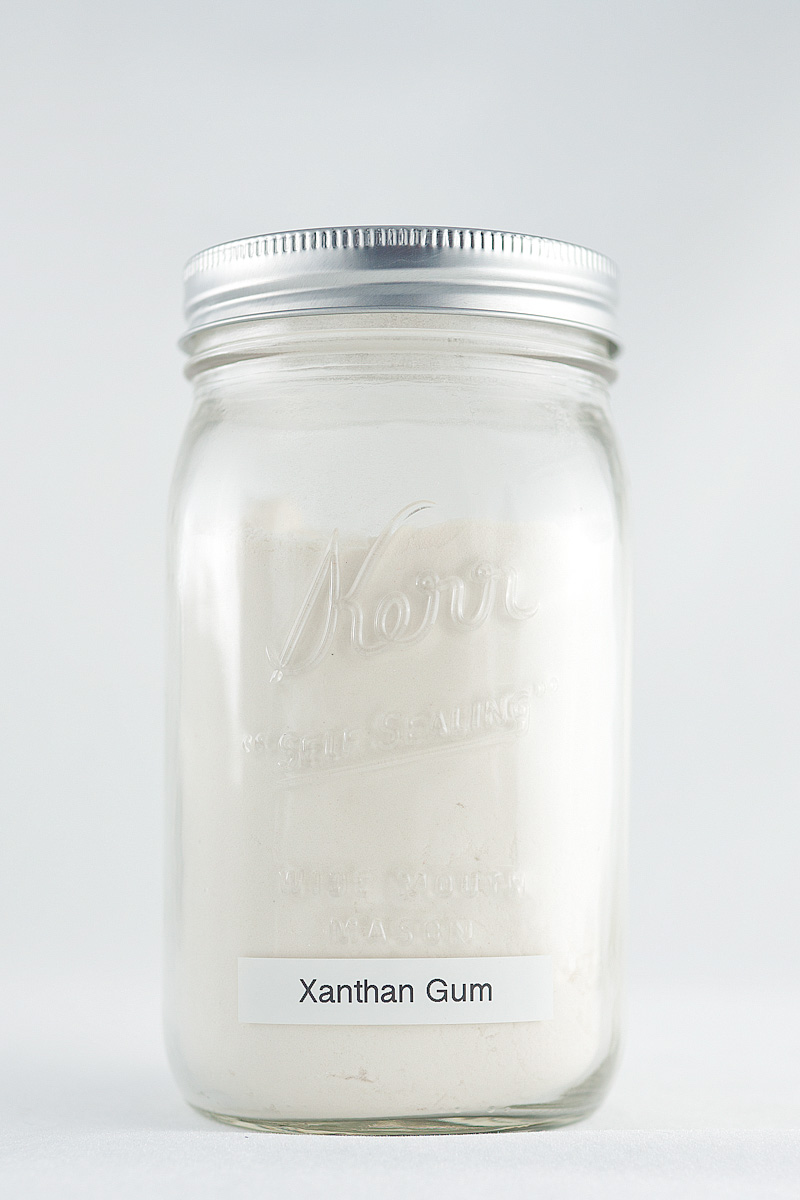
I’d always assumed that when these ingredients ‘went bad’ I’d know because they’d just stop doing what they’re made to do. I hadn’t anticipated development of off flavors though, which is what happened here. Despite being bummed about my passionfruit leather being potentially-ruined, I actually got really excited! Now I knew what to look for in these stabilizers to determine how fresh they were. Xanthan is one of the easier hydrocolliods to replace reasonably cheaply, and I haven’t noticed other powders having quite a strong, offputting scent, but I’ll keep my nose open going forward.
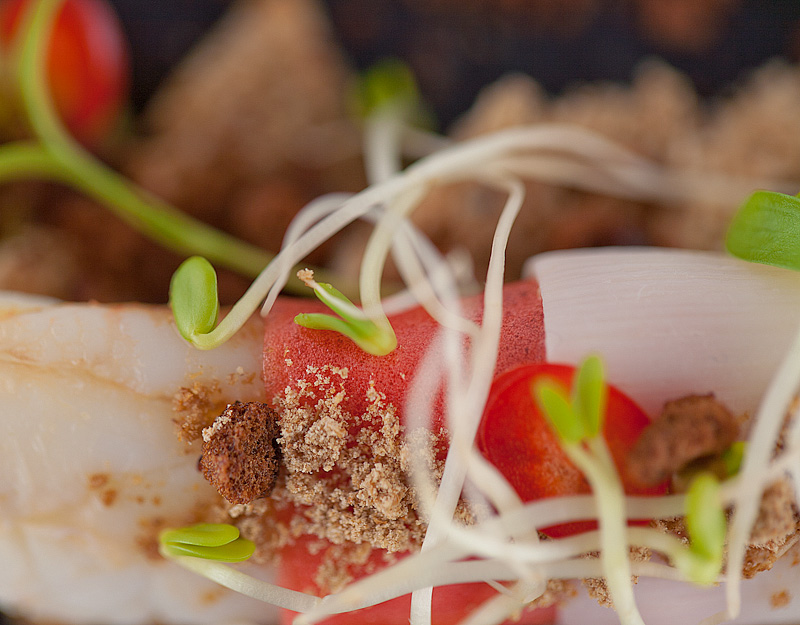
Interestingly, once dehydrated, the passionfruit leather tasted totally delicious; I couldn’t detect any of the odd cardboard flavors, so I kept it and used it (and Sarah happily ate all of it once I’d finished plating a few servings of everything).
Interesting Discovery #2 came when researching something the book calls a “Japanese Rotary Slicer”. Most google searches for this phrase yield something like this, which is actually misleading. These kinds of slicers slice from the end of a piece of produce, forming a spiraly sheet of whatever you’re cutting. This isn’t what’s intended here though. We desire to produce a long, thin, flat ribbon of heart of palm for this recipe, so I knew some different piece of machinery was needed. The thing I actually needed is often called a “vegetable sheeter”, and looks more like this. It also–in every instance I found one–is priced similarly: somewhere between $270-$250 for one of these things.
Though I love my kitchen gadgetry, that’s a pretty tough sell for me. I get that it does something pretty unique that seems hard to do otherwise, but that shit’s expensive. I wondered for a while how I might build my own version of this for cheaper, then thought to ask around at work to see if anyone had ever seen (or owned) anything like this. One friend responded, pointing out that these machines are meant to replicate this Japanese knife technique; he jokingly suggested maybe I should just teach myself how to do that.
Ok, so, yeah, clearly I tried this.
For this recipe, what I need to do is cut a heart of palm into 1/2″ disks, then roll each disk across a blade to thinly, thinly trim it into one long flat ribbon. I tried doing this with a paring knife and found it to be hard as hell. After a half-hour of messing tediously with it, I kinda sorta got the hang of it, but it was too tiny for me to hold without jarring it every time I needed to reposition my fingers, which caused it to tear really easily. I eschewed the paring knife for a vegetable peeler and had better luck with this; it was hard to get something as glassily-clear as the daikon that chef is getting in that video, but I let myself call it good enough for this dish.
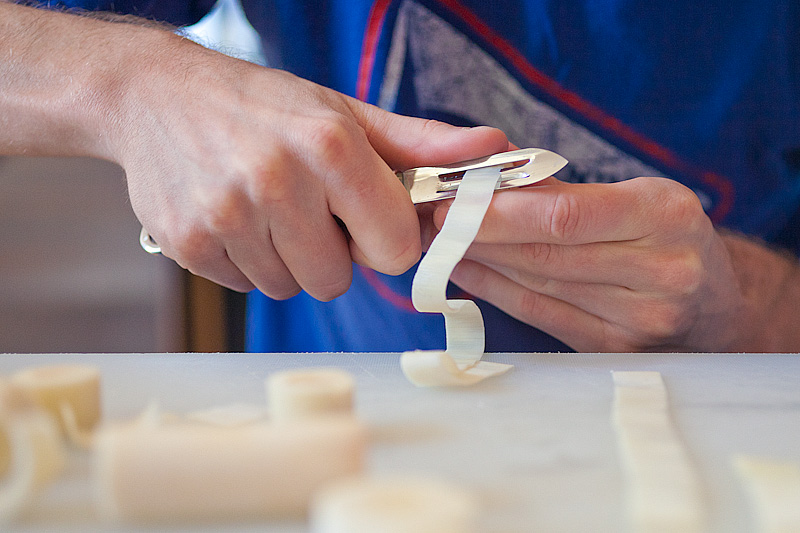
The heart of palm ‘noodles’ are cooked sous vide in a lime vinaigrette, another new trick I’d not seen before. They take on a lovely tender quality, with a bright acidic node from the lime.
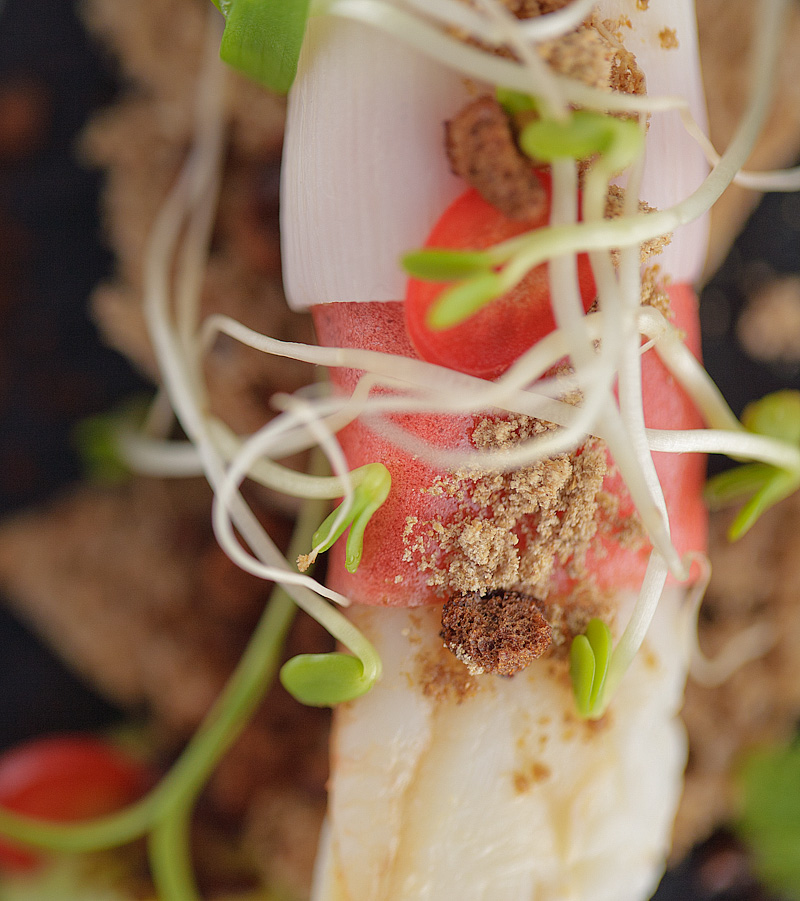
For the bread ‘shingles’ under the crab assembly, I cut a loaf of whole wheat bread into slices as thinly as possible, then sprayed them with a mist of sesame oil. The misting was prescribed by the recipe. I tried loading some sesame oil into a little cheapy garden water spray bottle I had, but it clogged and gunked up the nozzle, so I backed up and bought an oil mister from Amazon. This thing is pretty neato! I got a glass one so I can see what’s in it; it comes with a small hand pump lid thing to pressurize it, after which it sprays a nice fine mist. After spraying the bread with this mist, I baked it in the oven for a half hour or so, until the slices were extremely crispy.
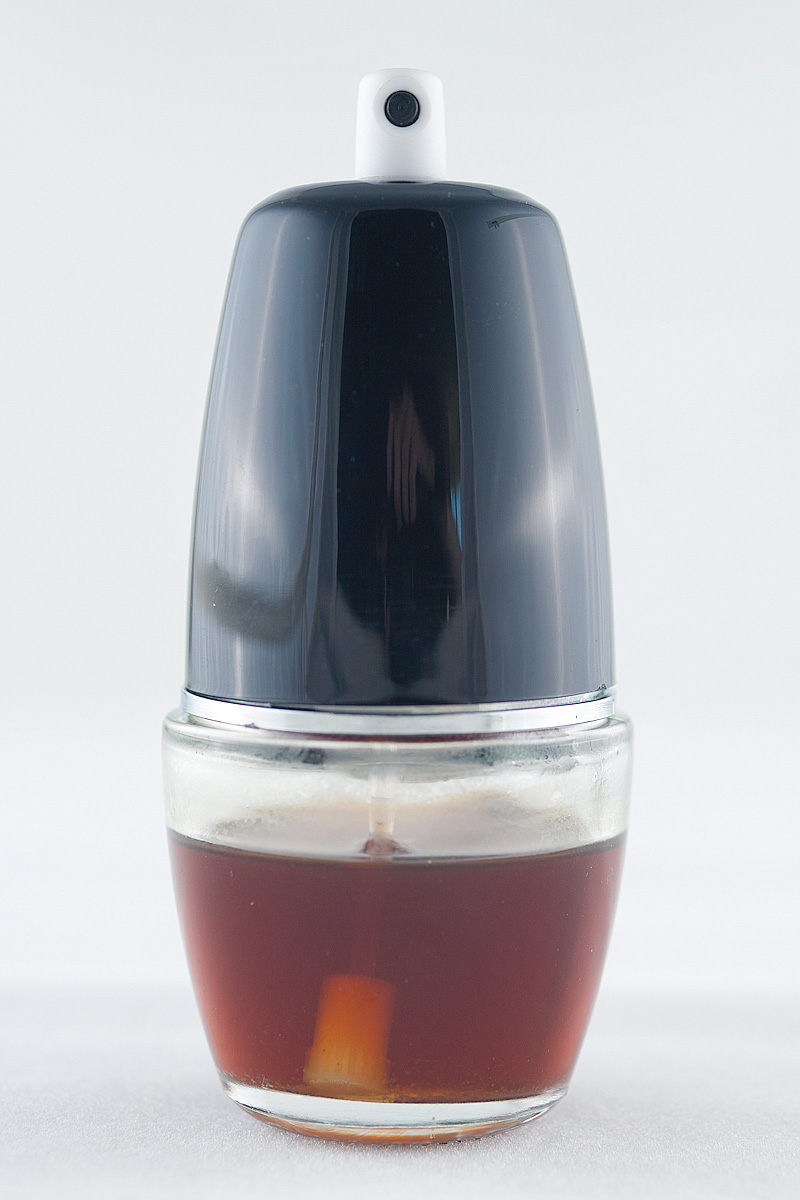
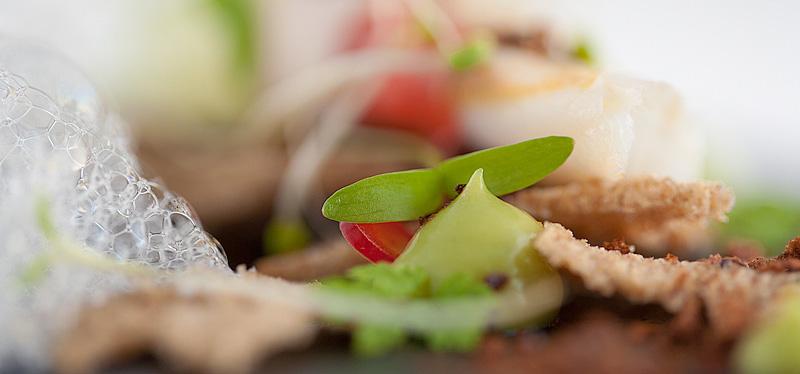
To make coriander salt, I toasted some dried coriander seeds until they were fragrant, then mixed them with some salt and ground them in a spice grinder into a fine powder. I sifted this through a tea strainer into a little storage jar to hold fresh until plating time.
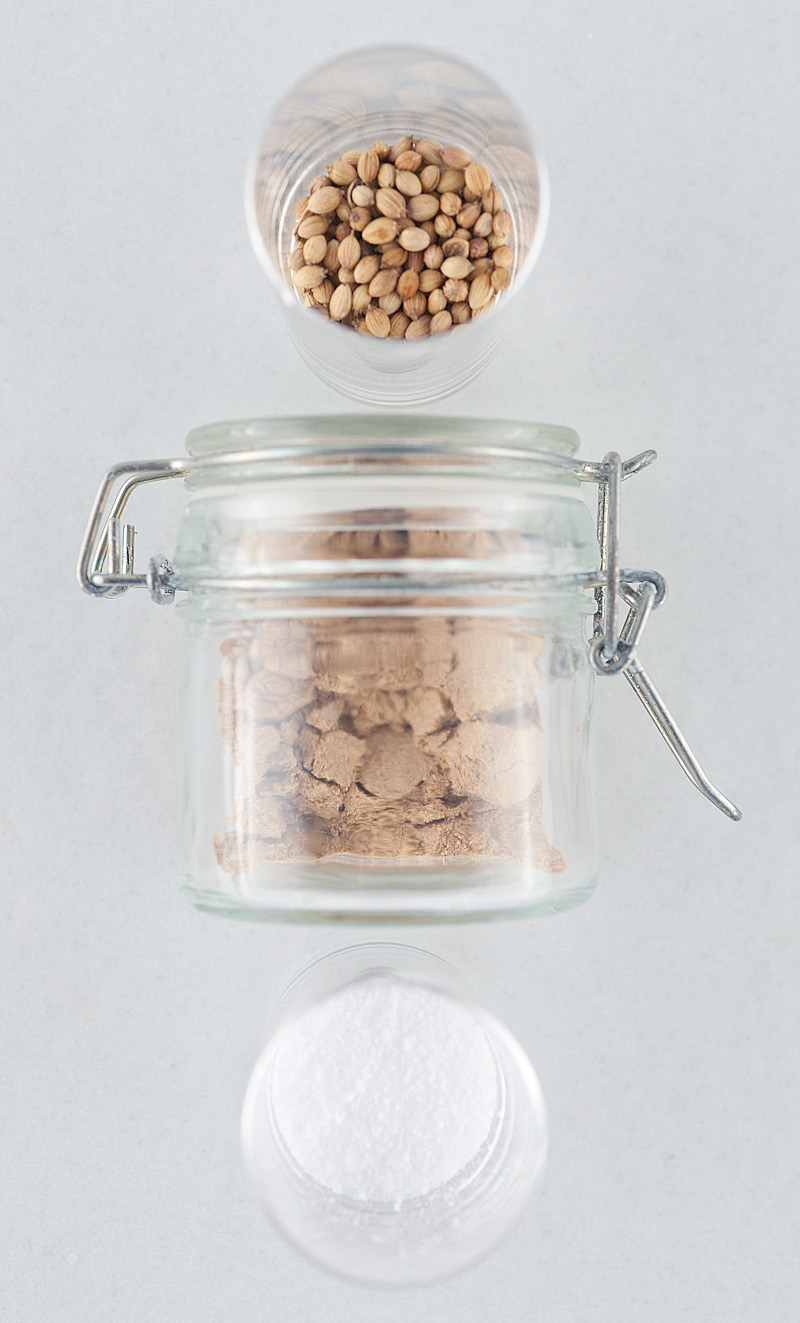
Making coconut dish soap bubbles was another neat discovery. So far, making ‘bubbles’ has involved blending a liquid with soy lecithin to form a light airy froth. This time, I was meant to mix coconut water with some egg white powder and xanthan gum, then–get this–stick an aquarium pump hose into it to let it bubble for a while.
For the coconut water, I found these “extra-peeled” coconuts at Berkeley Bowl. They’re cheaper than regular young coconuts (!), and come with most of the husk gone. To drain them, all I had to do was trim off the small cap of husk at the top, then poke a hole through the soft eye beneath it. Super easy-peasy.
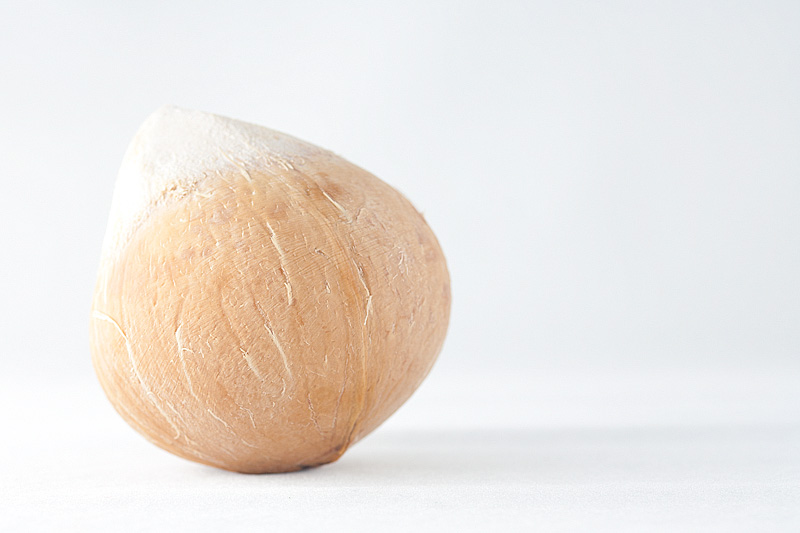
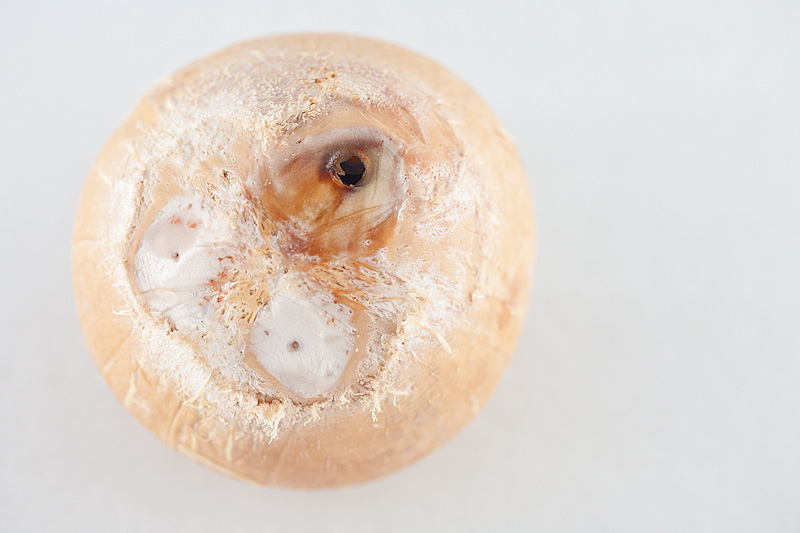
I used an immersion blender to blend in the egg white powder and more xanthan; the egg white powder I found on Amazon, along with a cheap aquarium pump and some tubing.
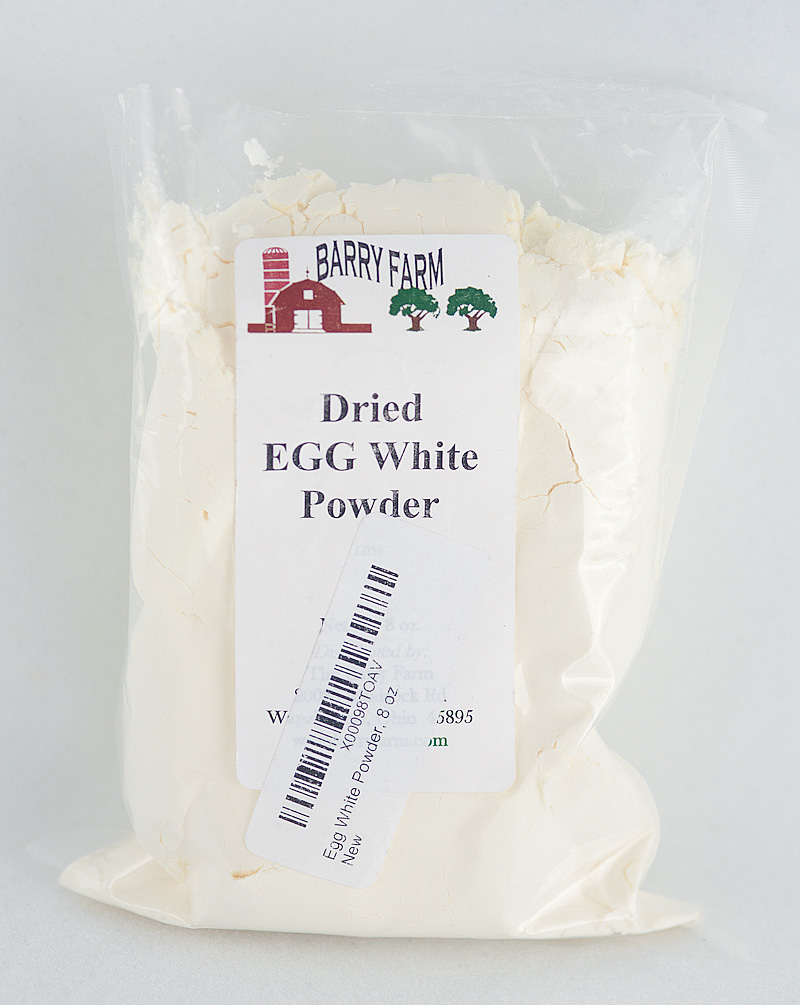
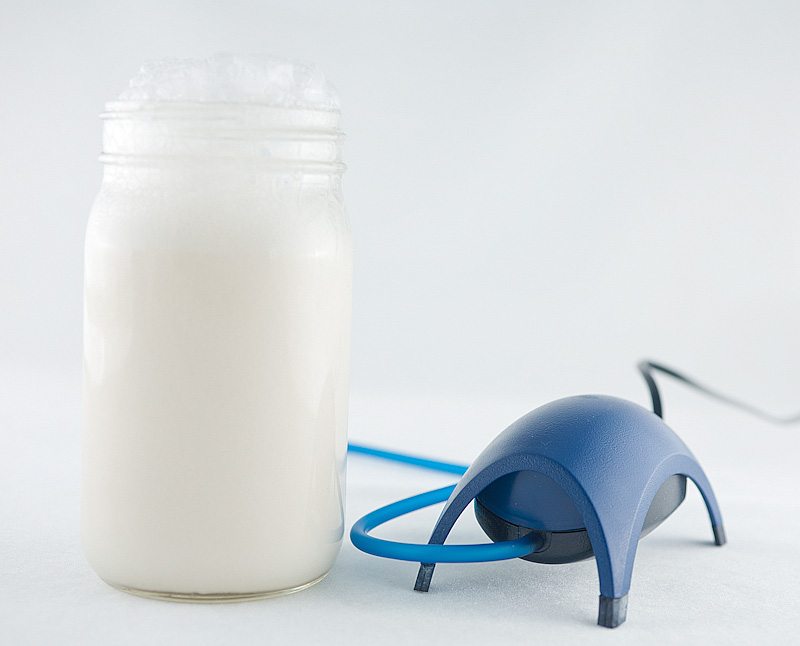
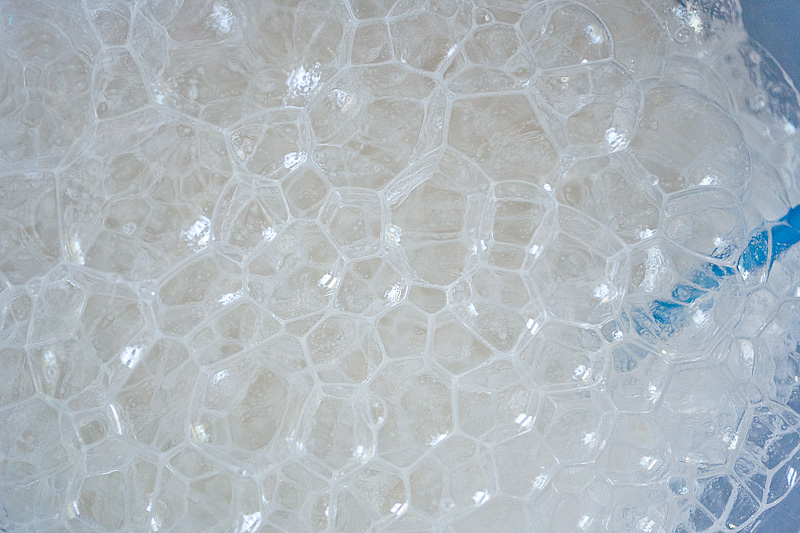
The bubbles formed by the aquarium pump were much larger than those formed using lecithin/immersion blending; they literally look like dish soap bubbles., even down to the oily film from the fat in the coconut water. I find it both neat and ridiculous that I now have an eye for ‘bubble style’ when making these sorts of foams.
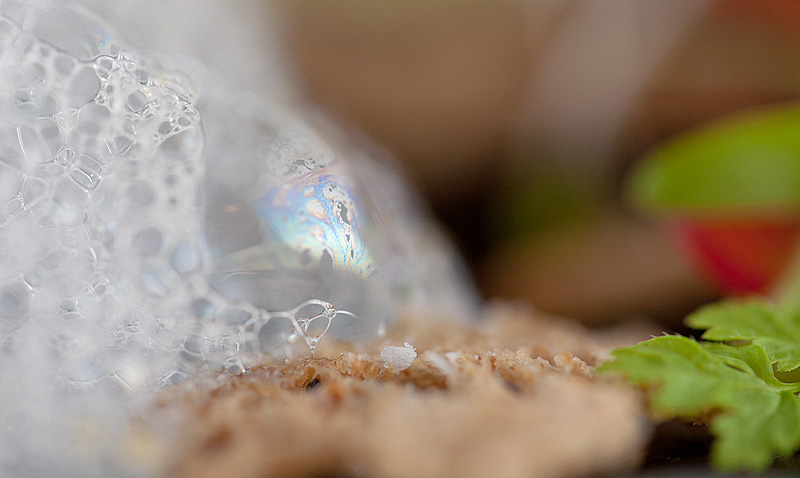
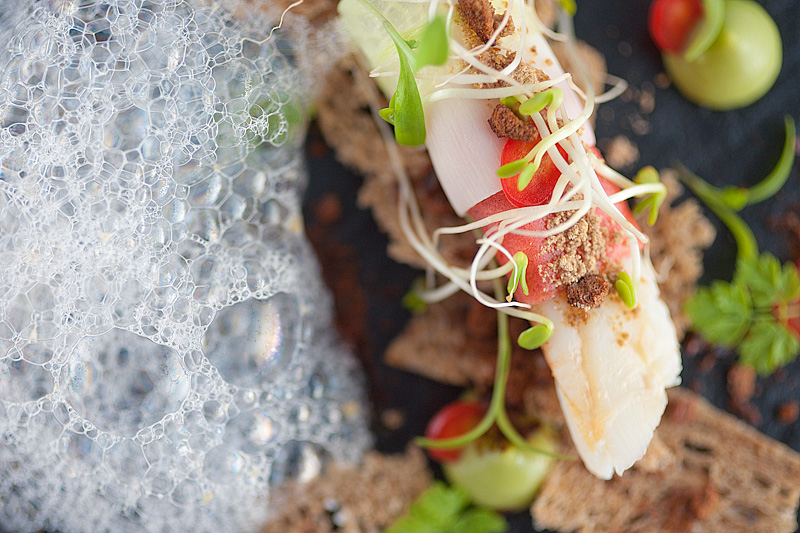
One of the components in the recipe calls for a “freeze-dried soy brick”, which I’m meant to break up into small pieces. There’s no elaboration on what exactly this is. I tried doing some searching, and found both spray-dried soy sauce powder and freeze-dried whole soybeans. Without more information to work with, I emailed Chef Achatz asking if I could trouble him to give me a clue as to what I should be looking for. Several days later (in fact, as we were in a cab riding to our El Bulli dinner at Next), I got an email from “Culinary Liason”. It wasn’t until I was halfway through reading it that I realized it was from another chef at Alinea, presumably writing me at the behest of Chef Achatz to answer my question. Once this hit me, I found it awesome for two reasons:
First, the Alinea Culinary Liason gave me an incredibly detailed explanation of what a “freeze-dried soy brick” was and where I could find it:
The product we use is from Kamebishi (http://www.kamebishi.com/) and it is branded as soy salt. We purchase the item through True World Foods ( http://www.trueworldfoods.com/ ) in 300g packages. If you would like to purchase a smaller amount then chefshop.com sells it in 80g packages on their website ( http://chefshop.com/Soy-Salt-P7404.aspx ).
Second, the email was signed “Eric Rivera” [the link here is provided by me]. This is 100% rad because I recognized Eric as a contributor to the Jet City Gastrophysics blog, which I’ve followed with interest for years. An interesting development in that blog’s history is Eric’s applying for and acceptance of a job at Alinea, which I read with great interest and envy. I excitedly responded to him telling him I recognized his name and that I was so excited to have come into contact with him in this way; I think he’s rad and that these circumstances were super-cool.
His advice was dead-on; I ordered “soy salt” from Chef Shop and it showed up a few days later. This stuff is neat: it’s very flaky and crunchy and airy–like anything freeze-dried–with a mild soy flavor that’s not nearly as overwhelming as I might have expected.
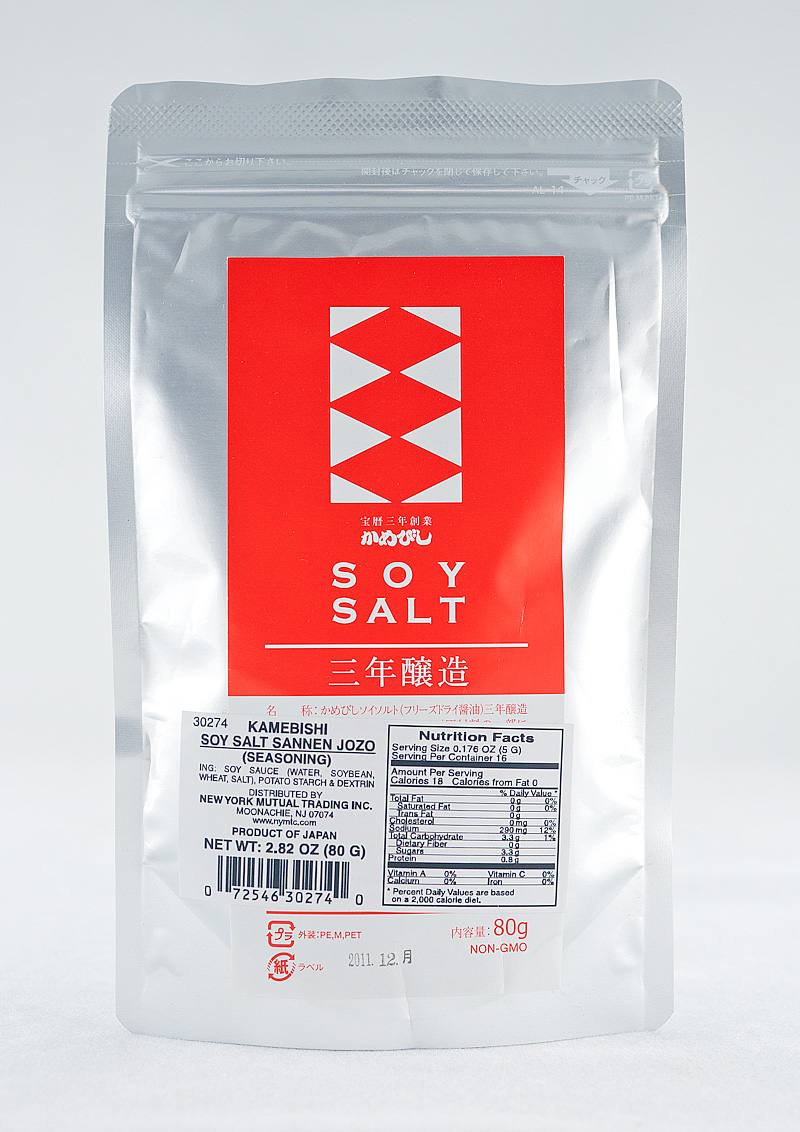
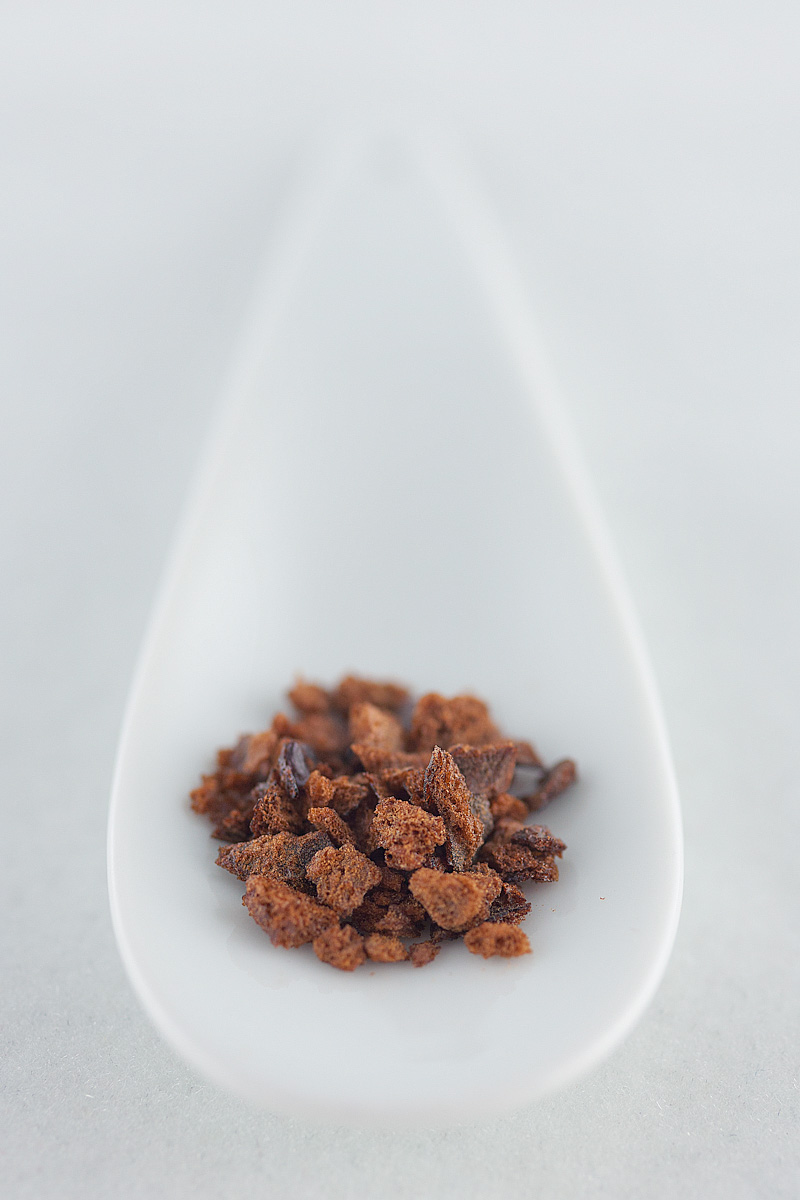
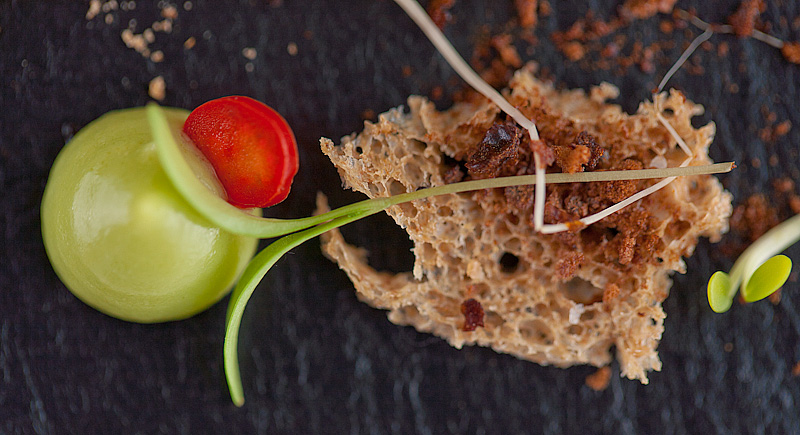
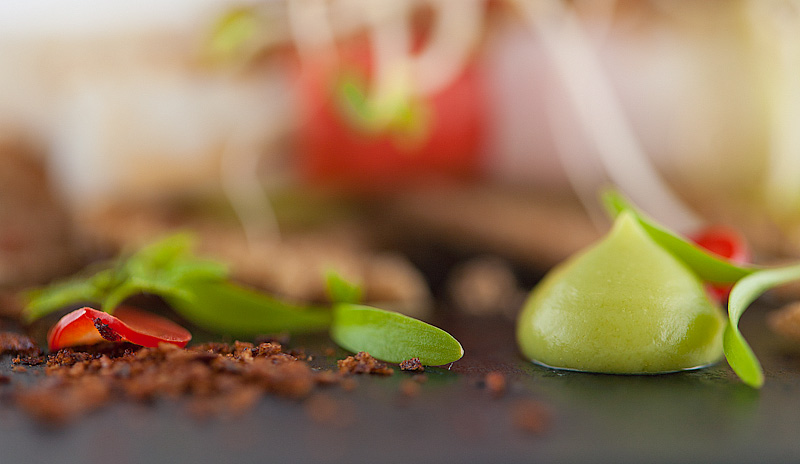
Since winter I’ve been slowly sprouting microgreens to use over the summer; here I used a batch of micro cilantro to garnish the dish, along with some sprouts I got at Berkeley Bowl. I also used fresno chilis as a garnish; these have a nice balance of sweetness and heat, not nearly as punchy as thai chilis, and with way fewer seeds and ribs to deal with.
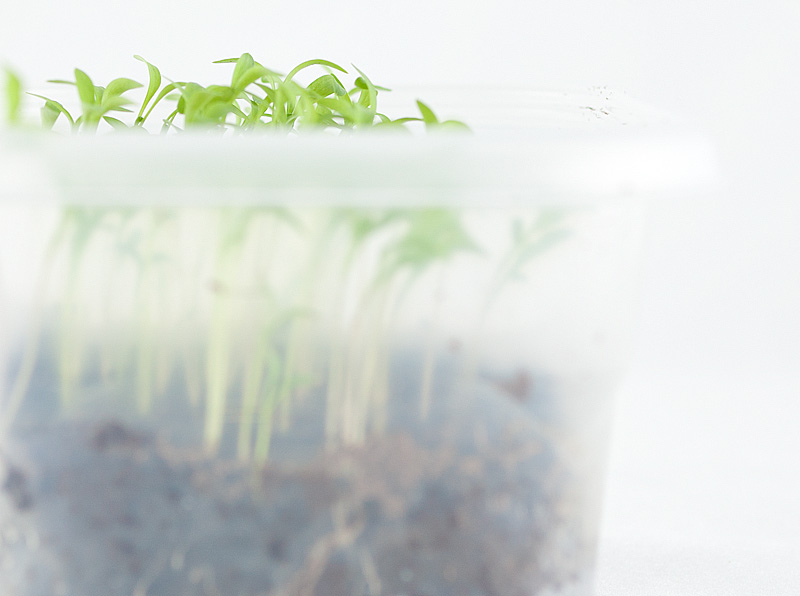
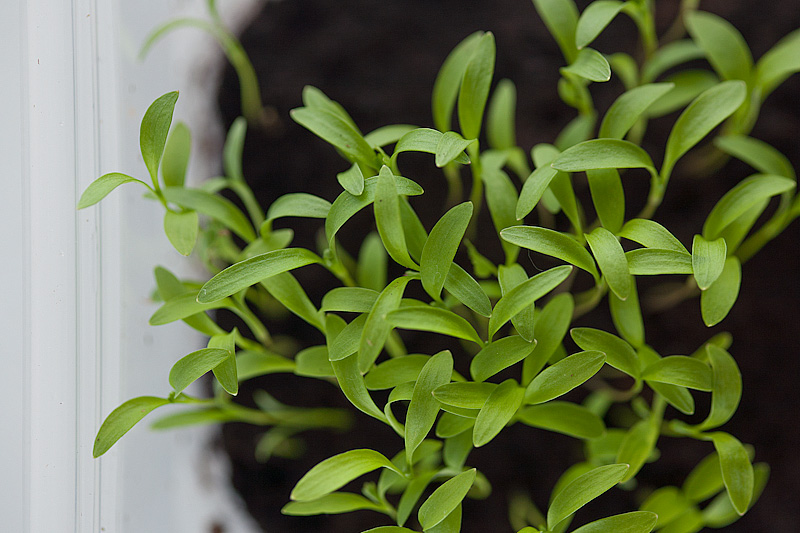
For extra credit, here are a few other things that happened during the course of making this dish. A few months ago I was having drinks with Joe and he ordered and Old-Fashioned with Chocolate Bitters. I didn’t think much of this until I tasted it; it was really somethin’ special! It piqued my curiosity about bitters, which ’til that point had only included basic knowledge of things like Angostura and Peychaud’s, neither of which I find particularly interesting. I bought a book about the history of bitters, and it includes several recipes for making one’s own. Excited by this idea, and with $20 worth of passionfruit rind left over from this dish, I thought I might try making some bitters with them. I stuffed a jar with as much rind as I could fit and filled it with Everclear, and will let it sit for 2 weeks to infuse (this is called making a “tincture” of a flavor).
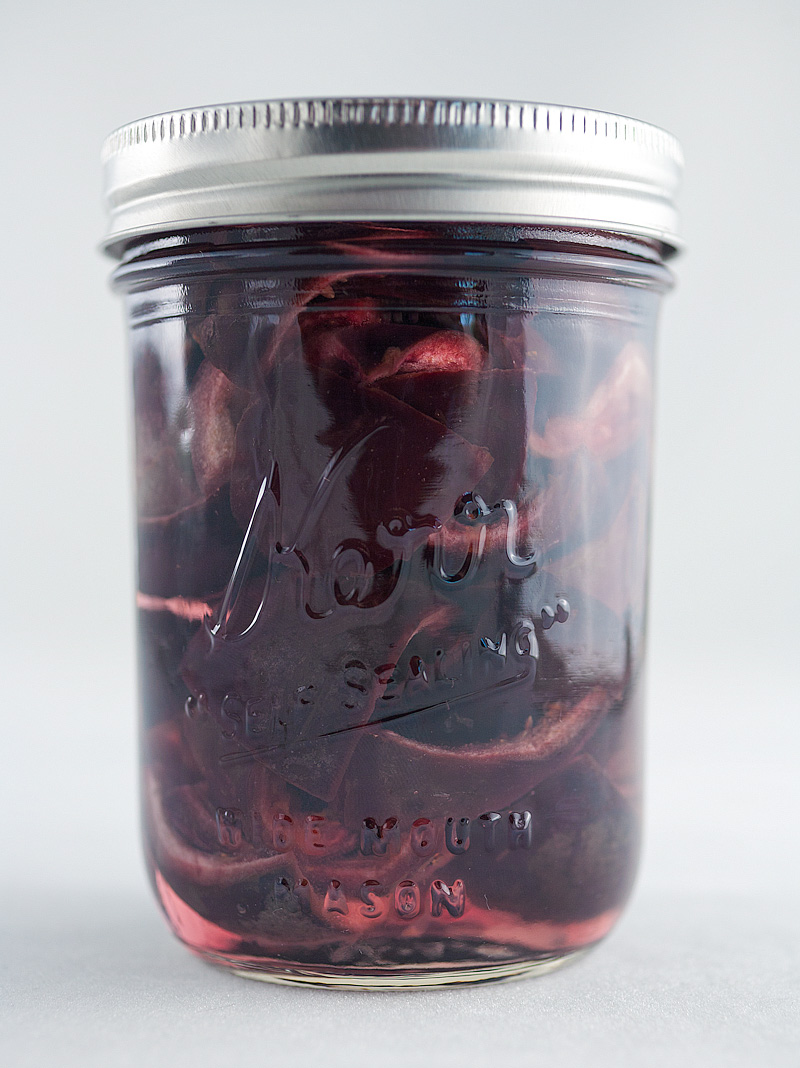
I thought the passionfruit flavor might work nicely with some herbal citrusy flavors, so I also started tinctures of lemon balm and lemon verbena, both going nuts in my garden at the moment. After two weeks, I’ll strain out the solids and can mix the individual tinctures to taste. I’ll also make a tincture of bittering elements like gentian root, to add the requisite bitter foundation to the final experiment.
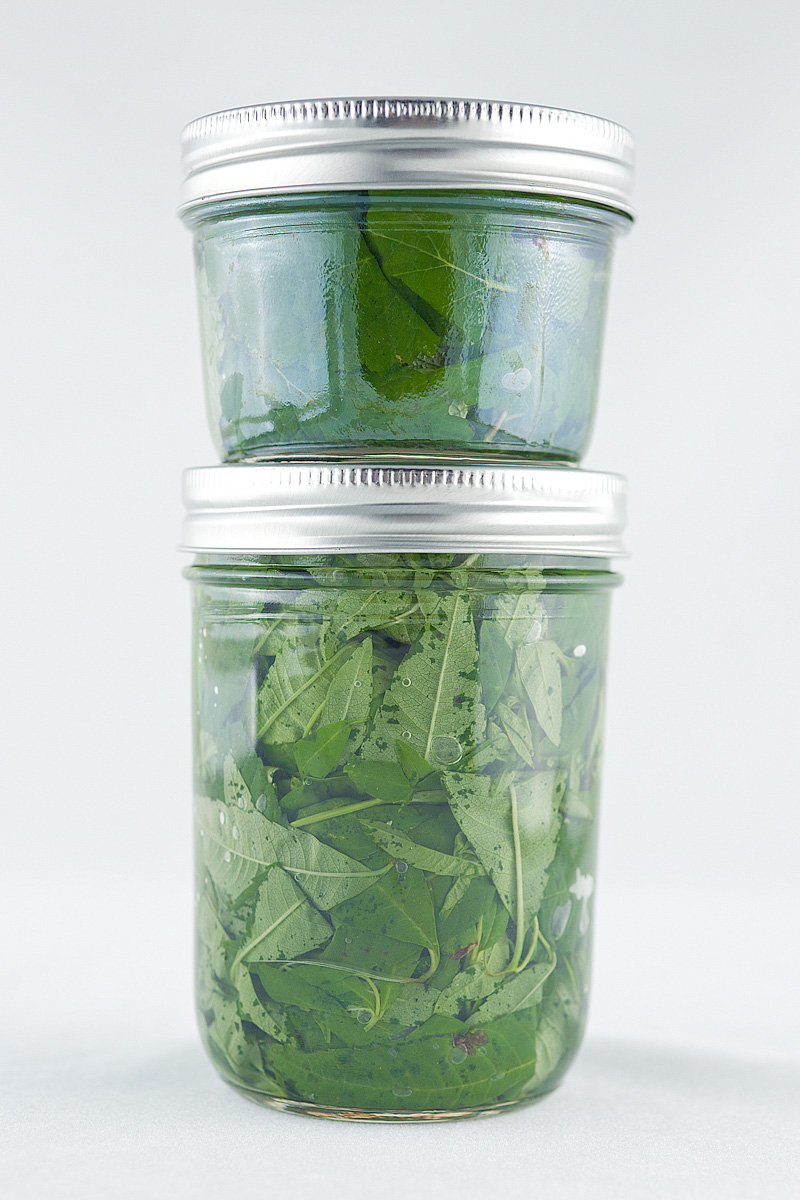
I also started taking a class on alternate process photography. I’m pretty excited about this; basically we’re making our own photo paper by mixing some chemicals and painting them onto regular fiber paper, exposing the paper to a negative under UV light, and developing the paper in several solution baths. Each print is unique, and they’re a little like painting or sculpture in that a photograph of the print doesn’t really do it justice; there’s a lot of texture to be experienced in touching and holding each piece.
The goal for the class– once we’ve learned the technique –is to embark on making a large body of work where we leverage what we’ve learned and adapt it to our own style. I have a pretty obvious bent towards food as a subject, but I’m not entirely sure this processing technique will serve that subject well. For me, photographing food so far has been about capturing the arresting colors and textures that I find so compelling about food, as well as trying to convey a sense of the sensual nature of cooking. Some of these elements are lost in this kind of printmaking, though they’re replaced by…’something else’. What that ‘something else’ is, and how it applies to this subject, is something I look forward to exploring. This is the first alt. print I’ve made, using a technique called “Palladium Printing”, resulting in a palladiotype.
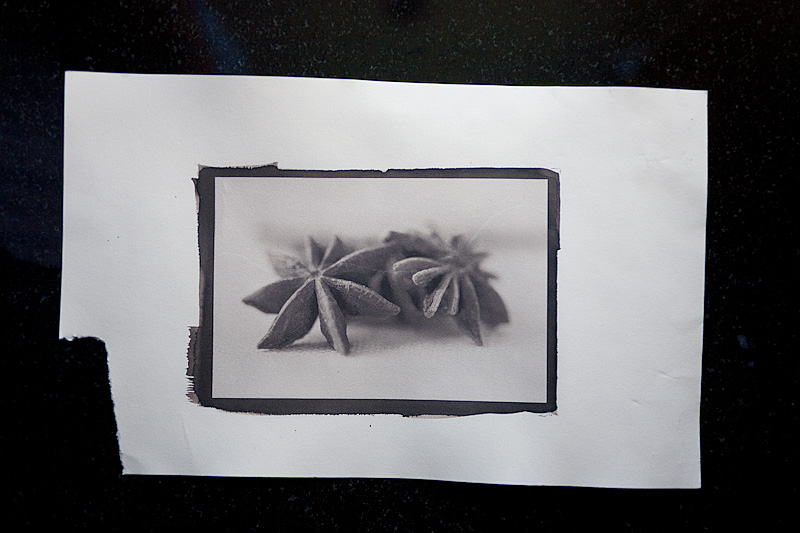
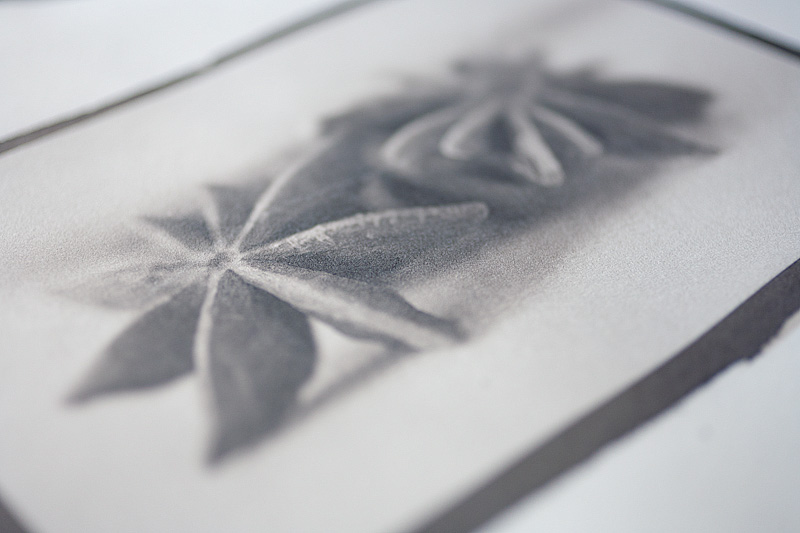
I’ll let ya know how that goes as the class unfolds.
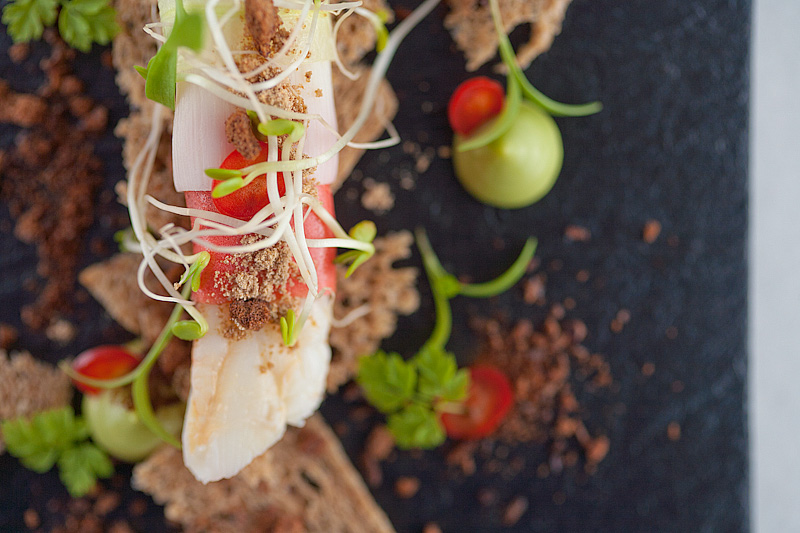
Hey Allen, thanks for sharing you discoveries- I had been wondering about that “freeze-dried soy brick” for a while. Gorgeous pictures as usual!
Between food geeks, I thought you might be interested in another use of aquarium pump-generated “large bubbles”- Sven Elverfeld (from a German 3* restaurant) covers foie gras and cherry gelee with chocolate bubbles. Though as chuckeats blogs (May 1), the idea may be pinched from Andoni Aduriz. Then again I made bubbles like that in my cacao when I was about 8…
Keep up the great work, love checking your updates. I’ve not had anywhere near your perseverance, but I’ve done squab, watermelon… and orange, olive oil… from the summer menu and loved them- something for you to look forward to.
Thanks for sharing your discoveries about the soy brick! I’d been wondering about it since seeing it in some recipes from Curtis Duffy in Art Culinaire, as well as in the Alinea book, and I’m grateful to have a definitive answer!